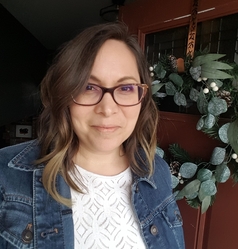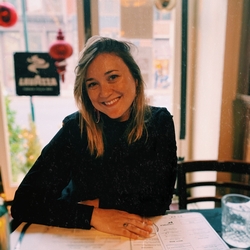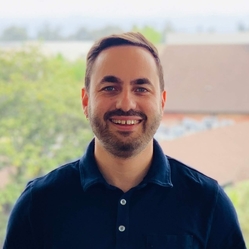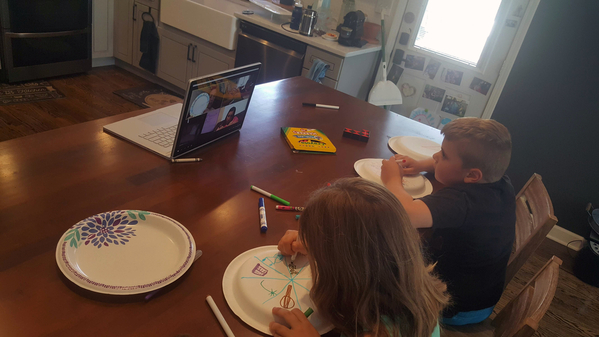In late May, Betsy Andersen’s 7-year-old son, Ezra, had a serious meltdown. He and his six-year-old sister Abby had been enjoying an online Zoom interaction with “Miss Eileen,” “Miss Savannah,” a couple of their colleagues, and a puppet.

“I could see him trailing off and then he started crying,” says Andersen, who lives in Mundelein, Illinois. But before she swooped in, she heard Miss Eileen talking to him: “She was saying ‘Hey, I see you’re having some big emotions.” Speaking through the puppet, Miss Eileen then led Ezra through some breathing exercises that helped him calm down and focus.
Andersen, like parents all over the country during the pandemic, has been looking for ways to fill the void left for her son and his sister while they’re shuttered inside, isolated and dealing with all kinds of feelings they don’t understand.
“I’m not taking my kids to the store or anywhere. They’re really lonely,” says Andersen, who is trying to keep them active and engaged while doing contract work as a graphic designer. The lack of a fixed schedule is also tough for her son, who gets additional help online for various emotional and developmental issues, though not as much as he received in person at school.
In fact, the facilitators on the Zoom call are particularly adept at working with children and families around times of profound traumatic stress. They’re trained in a specialty known as Child Life, which works with families on the grief, fear, and anxiety that children often experience while receiving medical care for serious illnesses or injuries. While Child Life specialists typically work in hospitals, some are pivoting into other areas and are now applying their skills to the fallout from the pandemic. Some have also been coming up with suggestions for ways to help children process feelings about frightful events captured in the news, such as the killing of George Floyd.
Among those who have branched out is Miss Eileen, aka Eileen Esposito, a Child Life specialist in Tampa, Florida, who helped develop the group sessions that Andersen’s children attended, called Coping through Connection. Esposito and her colleagues are part of an organization that had already stepped outside traditional medical settings, the Child Life Disaster Relief organization (CLDR), which operates virtually and includes 18 contract Child life specialists around the country.
The group was formed in 2016 to help mitigate trauma in children who have experienced disasters and crises. It also partners with organizations who are deployed to disasters, such as Children’s Disaster Services. It worked with children who lived through the devastating massacre at a country-and-western concert in Las Vegas in 2017, and with children and families who survived Hurricane Dorian in the Bahamas in 2019 and Hurricane Maria in Puerto Rico in 2017.
Much of their work involves child-led play, says Katie Nees, one of CLDR’s founders who lives in Cincinnati, Ohio. She recalls an experience working with children in a homeless shelter in Moore, Oklahoma, in 2013, which predates CLDR, but is instructive. Using cardboard boxes, magic markers, crayons and tape, the kids in Oklahoma built their own houses and networked with each other.
“They’d say things like, ‘You’re my neighbor, you’re my neighbor, if anything happens, we’ll stick together,’” says Nees. “After a couple days, they had a moment of high energy and ran around making lots of noise. They ended up ripping the houses to shreds,” she says, adding that the scene mirrored the reality of what was visible just outside.
After the demolition, the kids asked for time to sit and be calm, and Nees brought them snacks and drinks.
“We all sat together and [absorbed this feeling] of safety of the moment,” she recalls. “Watching them play out that entire situation the way they did it as a collaborative effort and then at the end just making time for safety and calm, was incredible. I’ve never seen anything like it.” (Here are some resources from CLDR.)
A turning point for Nees, who has worked in hospitals as a Child Life specialist since 2010, was when she came to understand how clearly the work of Child Life specialists was grounded in ACEs science.
In 2015, she read the groundbreaking book by science journalist Donna Jackson Nakazawa, Childhood Disrupted, which shows the links between childhood trauma and adult illness and offers ideas on how to facilitate healing. The book introduced Nees to the landmark CDC/Kaiser Permanente Adverse Childhood Experiences Study (ACE Study), which linked adverse childhood experiences (ACEs) to adult onset of chronic disease, mental illness, violence and being a victim of violence in more than 17,000 adults.
The ACE Study examined 10 types of childhood traumas, including living with an alcoholic or depressed parent or experiencing abuse or neglect. The study participants were mostly white, middle- and upper-middle class, college-educated, and had jobs and great health care. The study found that ACEs are common—most people have at least one. People who have four or more different types of ACEs—about 12 percent of the population—have a 1200 percent higher risk of attempting suicide and a 700 percent higher risk of becoming an alcoholic, compared with people who have no ACEs. Many other types of ACEs—including racism, bullying, a father being abused, and community violence—have been added to subsequent ACE surveys. (ACEs Science 101; Got Your ACE/Resilience Score?)
The epidemiology of childhood adversity—which produce ACE surveys—are one of five parts of ACEs science, which also includes how toxic stress from ACEs affects children’s brains, the short- and long-term health effects of toxic stress, how toxic stress is passed on from generation to generation, and research on resilience, which includes how individuals, organizations, systems and communities can integrate ACEs science to solve our most intractable problems.
Nees says learning about the ACE Study changed everything for her.
“It was the first time I had found something that really quantified the importance of mitigating stress and trauma in childhood,” she says. ACEs science also reinforced for her the relevance in Child Life work of creating safe places for children, where they can express their emotions to supportive adults, who can help them process those feelings and build resilience.
To get a sense of specific needs that were bubbling up in communities around the pandemic, Nees, Esposito and their colleagues conducted impromptu focus groups among parents and educators in April.

“We saw that the biggest glaring need was the need for connection,” says Esposito. That realization led to Child Life’s online Coping through Connection series, which has served about 75 children, once a week, for eight weeks.
As was the case for the kids in Oklahoma, the children participating in the online groups were also allowed to lead.
“We’re not teachers who are going to stand up and provide a lesson. We’re supportive adults who are there to see what comes up with the children themselves and let them lead the conversations,” Esposito says.
In Andersen’s group, for example, she says they asked the children what activities theywanted to do.
“What do you want to do after the opening song? Do you want to play charades in the middle or at the end?” they asked the kids. Then they created a visual schedule that the children could refer to. And when children are visibly upset, the adults encourage them to share their feelings, as they did with Andersen’s son, Ezra.
Esposito gives an example of a technique to help a child cope and build resilience: naming and locating a magic power.
“One of the kids assigned a plant with the superpower to make everybody happy with a smile. It was so sweet,” she explains. “What he was communicating was that he sees and senses fear around him. He knows that people are not happy. He’s not happy. He doesn’t get to go to school. Mommy’s all of a sudden home all the time, and she’s stressed out, working from home and yelling more.”
Because some of her colleagues are seeing children in their own communities who’ve expressed fear connected to the killing of George Floyd, Esposito says that they want to be prepared should it come up in an online group.
A common response among young kids when they see disturbing news on TV is to personalize it, Esposito explains.
“It could be ‘George Floyd looks like my dad. Is this going to happen to my dad or to me and my family?’” As Esposito sees it, it’s an opportunity for a Child Life specialist to allow the child to express their fear, and then use a developmentally-appropriate intervention that the child chooses. For example, she says, “They can draw their safe place or their families. And to further empower the child in feeling safe, brave and strong, have them identify the strong members of their family.”
While CLDR is now looking to revamp their online offerings, which have continued through July, Child Life specialists elsewhere are being tapped to respond to in-person needs around the pandemic. Wenonah Elms, the disability and mental health coordinator for the City of Oakland’s Head Start program, is one person who reached out to local Child Life specialist Jonathan Iris-Wilbanks with concerns about what reopening would look like.
“How do we ensure the mental health and social wellbeing of the teachers and the children in an environment where there is increased anxiety and [so many new] health and safety protocols?” asks Elms. She also ticked off a number of other concerns, like how to deal with children who are constantly wiping their nose, sharing bodily fluids, and touching things.
Iris-Wilbanks, who is the director of the graduate Child Life program at Mills College in Oakland, California, and a Child Life specialist at Stanford Children’s Health/Lucille Packard Children’s Hospital in Palo Alto, California, describes some of the protocols that were used in hospitals to minimize the spread of infections while children were involved in play, which he shared with Elms.

“If we're going to use playdough,” he says, “we'll just make a really big batch of it, and we'll put out half for the morning and then use the rest in the afternoon.”
Iris-Wilbanks also gave Elms some innovative ideas to consider: “Think about doing a sensory project that incorporates community” he suggests. “If all of our focus is on cleaning, and hand hygiene, why not do a community project where kids are sweeping the outdoor play space? Or have bins of soapy water so that kids can wash the truck together?”
All of the preventive measures for safe play harken back to enabling children to feel connected in the midst of the pandemic. During an exercise developed by Coping through Connections to create a “coping wheel,” Andersen’s son, Ezra, who sometimes struggles to express himself verbally, was busy drawing.

“I looked over, and he had drawn five or six people interacting on a computer screen. He wouldn’t have been able to say that one of his coping skills was talking with his friends in this group on a computer screen, but he drew it,” says Andersen. “It was such a confirmation.”





Comments (0)